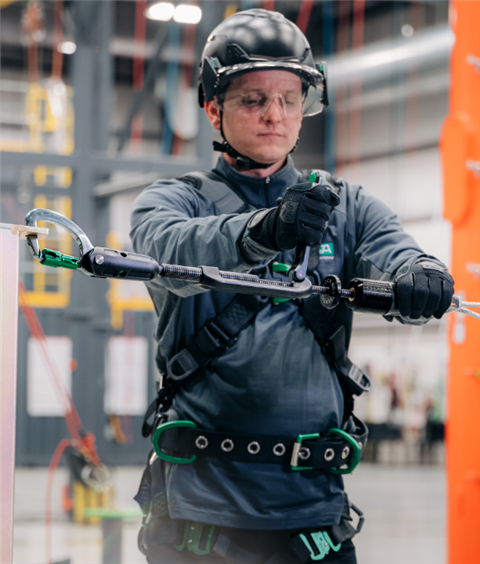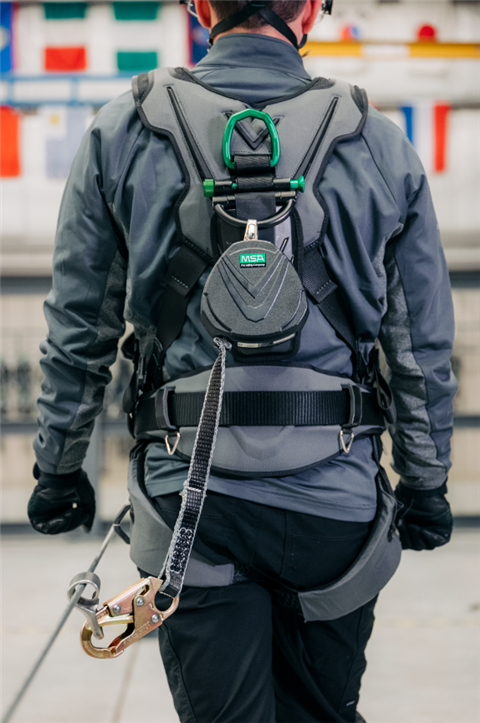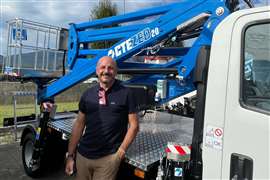Falls from height: Will your safetyline save you?
19 October 2022
Can workers be sure their temporary horizontal lifeline will save them in the event of a fall from height? And can such equipment be made easier and quicker to deploy, as well as safer? Alfonso Fernandez of MSA Safety sums up the risks and challenges in this area.
 US-based MSA Safety’s Temporary Horizontal Lifeline can be installed by a single site worker. (Photo: MSA)
US-based MSA Safety’s Temporary Horizontal Lifeline can be installed by a single site worker. (Photo: MSA)
The use of temporary horizontal lifelines is especially common in construction and industrial maintenance work. These are notoriously dangerous occupations, as statistics from the UK Health and Safety Executive (HSE) confirm.
The construction sector saw more fatal workplace injuries than any other in 2021/22, accounting for 24% of the total. Manufacturing followed at 18%. The most prominent accident category – representing 24% of all deaths at work – was falls from height.
Therefore using a suitable safety system, such as a temporary horizontal lifeline, when working at height is absolutely essential.
What is a temporary horizontal lifeline?
A temporary horizontal lifeline provides the anchorage for a fall protection system whose other essential components are a body harness and a connecting device.
The latter, which is often an SRL (self-retracting lifeline) or a PFL (personal fall limiter), connects the worker’s harness to the horizontal lifeline.
The most basic temporary horizontal lifelines are made from webbing. Others, using rope, offer a step up in quality, while premium-quality systems use steel cable.
Durability is an obvious issue. Webbing is the least durable option. It quickly becomes scratched, dirty and stained. These factors contribute to its deterioration and give the lifeline a shabby appearance which can make users doubt its reliability.
Rope is more durable and therefore safe for longer. Cable is better still.
For example, in developing the new MSA Temporary Horizontal Lifeline, the company’s design engineers have opted for galvanised steel cable to maximise durability.
At the same time, they have addressed several problems typical of traditional cable-based temporary horizontal lifelines.
In particular, the designers have replaced the complex, time-consuming set-up processes – typically requiring more than one pair of hands – with a faster, simpler approach. This allows users to spend more time on the work they are there to do, and less on setting up, so productivity losses are minimised.
When should temporary horizontal lifelines be used?
In industrial environments, temporary horizontal lifelines tend to be used in locations where work at height is needed only occasionally. If there is a frequent need in one place, it makes more sense to install a permanent fall protection system. For example, in the case of regular air conditioner maintenance.
Temporary horizontal lifeline applications, by contrast, could include a one-off machinery repair or a servicing task required just once every few years.
It would be impractical and expensive to build permanent solutions at every high point where work might potentially be required at some time.
Construction projects, by their very nature, alter in shape and height as they develop. To meet their changing needs, temporary horizontal lifelines can be continually moved into different positions.
Installing a temporary horizontal lifeline
A temporary horizontal lifeline must be connected to a firm anchor point at each end. The anchor points are normally beams or other solid structural features of a building, with the attachment usually made via anchor straps.
Once attached, the lifeline needs to be locked and tightened. While these have previously been slow procedures involving the use of nuts, bolts and wrenches, MSA’s lifeline features built-in locking and tensioning mechanisms that are located at the same end of the lifeline.
With no tools to be carried (and potentially dropped or lost) and no need for users to walk back and forth when installing it, the MSA Temporary Horizontal Lifeline is roughly 75% faster to install than traditional cable systems. That saving, multiplied across the many days on which the lifeline is set up in different locations, frees up substantial amounts of productive time.
Safetylines: confident locking and tensioning
A further issue on the installation of the fall arrest system is the firm locking and correct tensioning.
If the lifeline is not locked tightly enough, it might slip from the anchors. A loosely tensioned lifeline will deflect more than a sufficiently tight one if a worker falls. This creates potential for impact with the ground or other structures.
In webbing-based systems, locking and tensioning generally involve tightening until the worker can no longer turn the wrench further. Whether the right level of tension has been reached is a matter of judgement. Some rope or cable systems have a drum which is designed to slip when the lifeline becomes tight.
While some rope or cable systems have a drum which is designed to slip when the lifeline becomes tight, some utilise other features.
For example, MSA’s system incorporates coloured visual indicators on its inbuilt locking and tensioning devices, that clearly show whether the system has been set up correctly and is ready for use.
 The MSA system comrises a galvanised steel cable, a body harness and a connecting device. (Photo: MSA
The MSA system comrises a galvanised steel cable, a body harness and a connecting device. (Photo: MSA
Fall arrest safety: lifeline clearance height
Another aspect on which users want to be confident is how much clearance height is needed in the set-up for safety in the event of a fall. This needs to allow for lifeline deflection and other variables.
Traditionally, determining the clearance height has required the use of calculations combining data from the separate lifeline, connecting device and harness user manuals – adding extra time to the job.
However, the new system from MSA is one that provides easy-to-use charts on which the calculations have already been made. These take into account factors like the number of users connected (one or two) to the lifeline, the distance between its anchor points, the type of connecting device used, and whether the lifeline is at foot, chest or overhead level. This enables users to quickly ascertain the required clearance for each set of circumstances.
Multi-user horizontal lifeline systems
When two workers are connected to the same horizontal lifeline, a problem commonly arising is that they may need to pass each other from time to time.
To do so, one user must disconnect temporarily from the line – becoming unprotected until connection is restored.
Among the manufacturers that have developed systems to avoid this potentially fatal situation, MSA’s patented bypass shuttle feature ensures that workers stay secured to the line during passes.
Durability, strength and value
Another point of consideration is that, while web-based and rope-based systems are lighter to manoeuvre during installation and uninstallation, the strength and durability of a steel cable system is especially important when lifelines face abrasive, corrosive, dirty or polluted conditions, like those typically found on construction and industrial sites.
While fall prevention products like MSA’s temporary cable system, which can handle a weight capacity of up to 140kg - well above the 100kg minimum EU weight capacity, are generally more expensive, no price can be put on workers’ lives.
Employers and managers choosing the safest option can rest assured that they are minimising risks and investing in the wellbeing of their workforce. And given the choice, anyone who actually works at height would surely opt for that assurance too.
STAY CONNECTED



Receive the information you need when you need it through our world-leading magazines, newsletters and daily briefings.
CONNECT WITH THE TEAM











